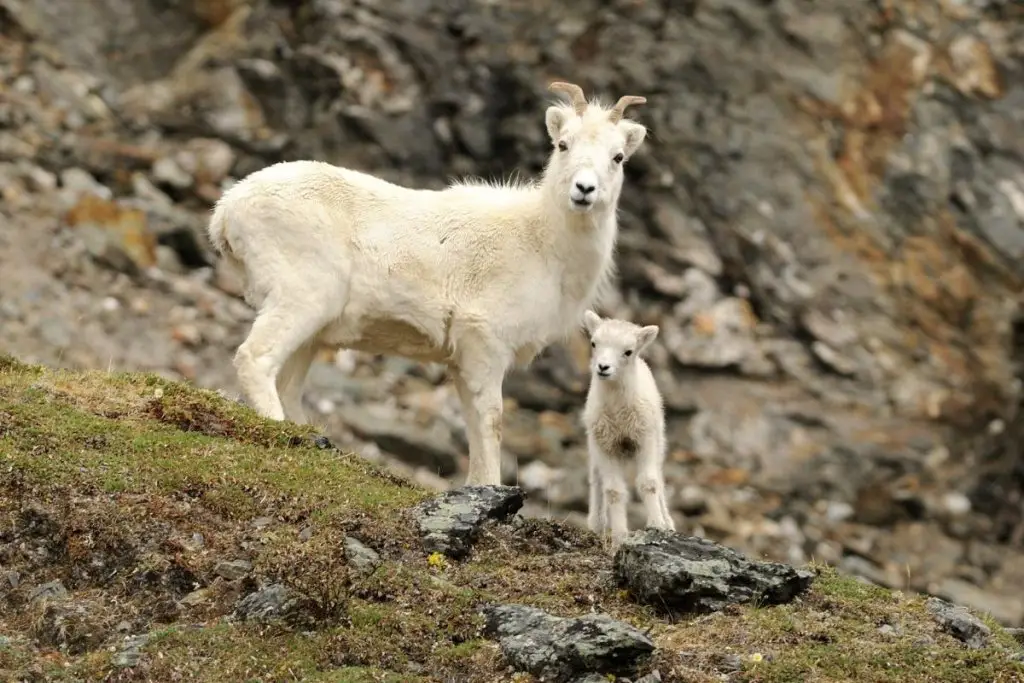Wild sheep have lived without humans for thousands of years. However, domesticated sheep are unlikely to survive long in the wild without human care—especially if they require shearing.
Table of Contents
Are There Wild Sheep?
Sheep lived in the wild for centuries before humans domesticated them in 5000BCE. Wild sheep still exist today.
However, domesticated sheep will struggle to survive in the wild. Breeders selected domesticated sheep not for survival traits but for wool and meat production, which means they no longer have the same survival advantages their ancestors had.
For example, domesticated sheep typically need shearing. Without it, their wool will grow heavy and cumbersome, and can cause death by drowning or by making them easier for predators to kill.
Where Do Wild Sheep Live?

Wild sheep live in different environments, such as mountains, rocky terrains, and forests. Their numbers have decreased over time due to threats such as hunting, climate change, predation, and diseases.
You can still find several wild sheep breeds roaming freely in various parts of the world, including:
- Asia – in the Himalayas, Tibet, East Asia, and Atalai mountains
- Middle East – in Iran, Turkey, Armenia, and Azerbaijan
- Southwestern America – in Nevada, Utah, Arizona, Southern California, and New Mexico
- North America – in Alaska, Southern Canada, Northern Mexico, and the Death Valley
- Europe – in Austria, Belgium, Croatia, Czech Republic, France, Hungary, and Spain
- New Zealand – in Arapaoa Island, Marlborough, and Pitt Island
What Are Some Common Breeds of Wild Sheep?
The common wild sheep breeds include:
- Bighorn sheep (Ovis canadensis): The largest wild sheep species. Commonly found in the rocky, high, and steep mountain ranges of North America. Like their name suggests, the males (rams) have large, curved horns. Females (ewes) display shorter, less curved horns. Bighorn sheep have gray, brown, or dark brown fur that becomes lighter (in color) and thicker during winter.
- Dall sheep (Ovis Dalli dalli): Like the Bighorns, Dall sheep rams have massive, curved horns, while the ewes have shorter, slender, and slightly curved ones. But the sheep’s white coat blends well with their snowy environment. Dall sheep are prevalent in the mountain ranges of Alaska. You can also find them in Yukon and British Columbia.
- Stone sheep (Ovis Dalli stonei): Also known as the ‘Black Sheep,’ the Stone sheep is a feral sheep breed found in the rugged wilderness and mountains of British Columbia. They resemble the Dall sheep in physique but have a dark-colored coat.
- Argali sheep (Ovis ammon): These are wild sheep species in East Asia. They mostly roam the Himalayas, Atlas mountains, and Tibet. The sheep live in high-altitude areas to evade predators. They’re also found in the forested regions of Kazastahan.
- Mouflon sheep (Ovis aries): They’re the closest ancestors of domesticated sheep and live in Asia. You’ll find them in Iran, Armenia, Turkey, and Azerbaijan. These wild sheep have short, dark brown coats with black stripes above the knees. The females are hornless. Males have downward-curved horns.
- Snow sheep (Ovis nivicola): These wild sheep are closely related to the Bighorn sheep of North America. You’ll mostly find them in the mountains of eastern Siberia. The males have more prominent horns and more weight than the females.
How Do Wild Sheep Survive?

Wild sheep have various defense mechanisms that enable them to survive in the wild. These include:
- Adaptation to multiple conditions: Unlike other mammals, wild sheep adapt to harsh climatic conditions in the mountain ranges. Their firm hooves enable them to climb the rocky terrain, keeping them safe from predators. Moreover, their fur coats grow thick during winter and shed naturally when the weather becomes warmer.
- Herd Mechanism: Although sheep can live independently, they prefer staying in herds of 20-30 sheep. This helps them wade off predators.
- Physical Defenses: Most male wild sheep have large curved horns. In addition to displaying dominance in contests with other sheep, these horns aid in defending them from predators.
- Feeding Habits: Wild sheep are mainly grazers and ruminants. Their stomachs have several chambers allowing them to extract nutrients. They feed heavily when food is abundant and can survive for days without food when it’s scarce.
- Body Anatomy: Wild sheep are larger and leaner than domestic sheep. This helps them withstand attacks by predators. They have strong instincts to detect the presence of predators.
Do Wild Sheep Need To Be Sheared?
Wild sheep don’t require shearing. They shed their coats naturally.
Wild sheep breeds adapt to the changing weather conditions. Their coats thicken when the temperatures drop. Their thick coats enable them to survive freezing winter conditions.
Wild sheep then shed their thick coats to keep cool in the summer. They may also scratch their bodies against rocks or trees to remove excess hair.
What Is the Difference Between a Wild Sheep and a Domesticated Sheep?
Wild sheep have a much higher chance of surviving in the wild than domesticated sheep. They’ve evolved traits that help them adapt and protect themselves.
| Differences | Wild Sheep | Domesticated Sheep |
| Behavior | Fend for themselves. Are more aggressive and defensive. | Need humans to take care of them. Tend to be less aggressive or even docile. |
| Environment | Often harsh, rugged, mountainous conditions | Often raised on grassy plains. May live in shelters during harsh winter conditions. |
| Diet | Grass, leaves, shrubs, seeds | Grass, legumes, grains, supplements, silage, hay |
| Shearing Vs. shedding | They shed their coats | Require regular shearing. They don’t shed their coats naturally. |

